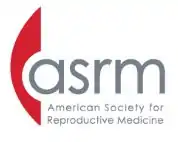American Society for Reproductive Medicine
The American Society for Reproductive Medicine (ASRM) is a nonprofit, multidisciplinary organization for advancement of the science and practice of reproductive medicine. The society has its headquarters in Washington, D.C and its administrative office in Birmingham, Alabama.[1]
American Society for Reproductive Medicine | |
 | |
| Abbreviation | ASRM |
|---|---|
| Formation | 1944 |
| Headquarters | Washington, DC |
President | Michael A. Thomas, M.D. |
Chief Executive Officer | Jared C. Robins, M.D., M.B.A. |
| Website | www |
Formerly called | American Society for the Study of Sterility, American Fertility Society (AFS) |
History and activities
Founded in 1944 by a small group of fertility experts who met in Chicago, the initial name was the American Society for the Study of Sterility, changed in 1965 to American Fertility Society (AFS). The current name was adopted in 1994. In 2018, ASRM created its own research institute. In 2019, it moved its headquarters to Washington, D.C., from Birmingham, Alabama.[2]
Though primarily an American organization, it had members from over 100 countries as of 2020.[3][4] The society hosts an annual scientific congress, as well as courses, seminars, workshops and publications. Special interest groups are focused on a range of reproductive medicine topics. ASRM has an Ethics Committee that provides guidance on ethical issues.[5][6] The ASRM Practice Committee issues clinical guidelines and reports.[7]
World Health Organization NSA status
In May 2014, the ASRM became an associated a non-state actor (NSA) with the World Health Organization (WHO).[8]
Publications
Publications of the ASRM[9] include:
- Fertility and Sterility – Peer reviewed monthly official publication of the American Society for Reproductive Medicine, Society for Reproductive Endocrinology and Infertility, Society of Reproductive Surgeons, Society for Assisted Reproductive Technology, Society for Male Reproduction and Urology, Pacific Coast Reproductive Society and Canadian Fertility and Andrology Society.
- Journal of Assisted Reproduction and Genetics – Published monthly; was published as Journal of In Vitro Fertilization and Embryo Transfer before 1992
- Ethics Committee Reports and Statements – Ethical issues in reproduction are addressed by the Ethics Committee that published guidelines for medical practitioners.
- Practice Committee Guidelines – Practice Committee summarizes consensus opinions on medical standards and educational bulletins.
- Patient Education Fact Sheets and Booklets – series produced under the direction of the ASRM Patient Education Committee and the Publications Committee.
See also
References
- "ASRM – About". Retrieved December 25, 2010.
- Move of headquarters to Washington, DC
- "American Society for Reproductive Medicine Updates Mission, Vision and Values Statements". AMA Alliance (Press release). PRNewswire. August 12, 2020. Retrieved August 13, 2020.
- Duka, Walter E.; DeCherney, Alan H. (1995). From the Beginning: A History of the American Fertility Society 1944–1994. The American Fertility Society. p. 5. ASIN B001C0ITLO.
- "Embryo battles are likely to get a precedent in San Francisco couple's case". Los Angeles Times. ISSN 0458-3035. Retrieved September 30, 2015.
- "Report documents gaps in infertility treatment access". Urology Times. Archived from the original on October 2, 2015. Retrieved September 30, 2015.
- Marcotte, Amanda (October 19, 2012). "Freezing Your Eggs Is No Longer Experimental. But It's Still Not the Path to Having It All". Slate. ISSN 1091-2339. Retrieved September 30, 2015.
- "Sexual and reproductive health:Infertility" (Press release). World Health Organization. Archived from the original on September 30, 2017. Retrieved September 30, 2015.
- "ASRM – Publications". Archived from the original on April 13, 2011. Retrieved December 25, 2010.
External links
- ASRM Home page
- Fertility and Sterility
- Journal of Assisted Reproduction and Genetics
- ReproductiveFacts.org – the ASRM patient education portal